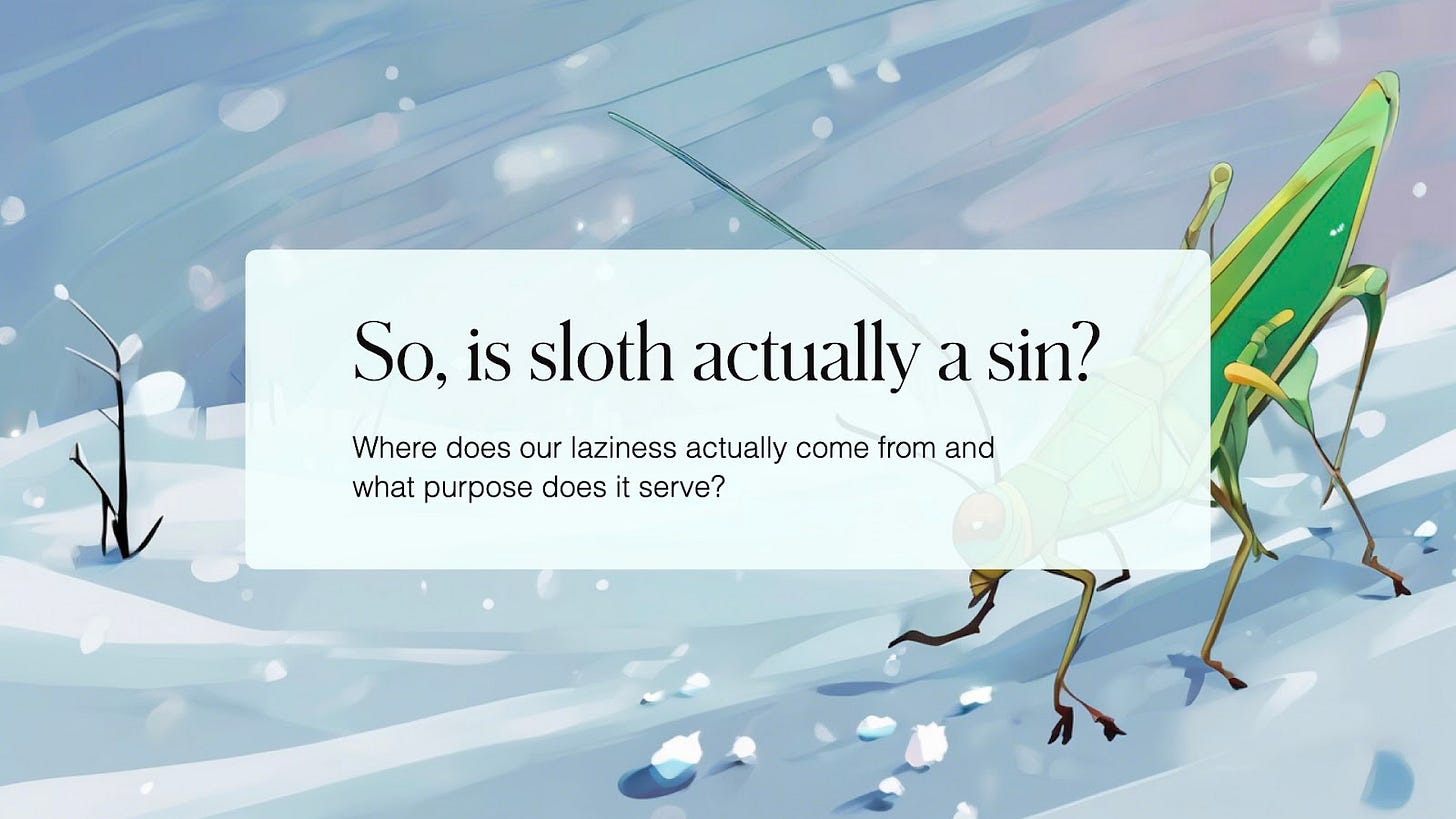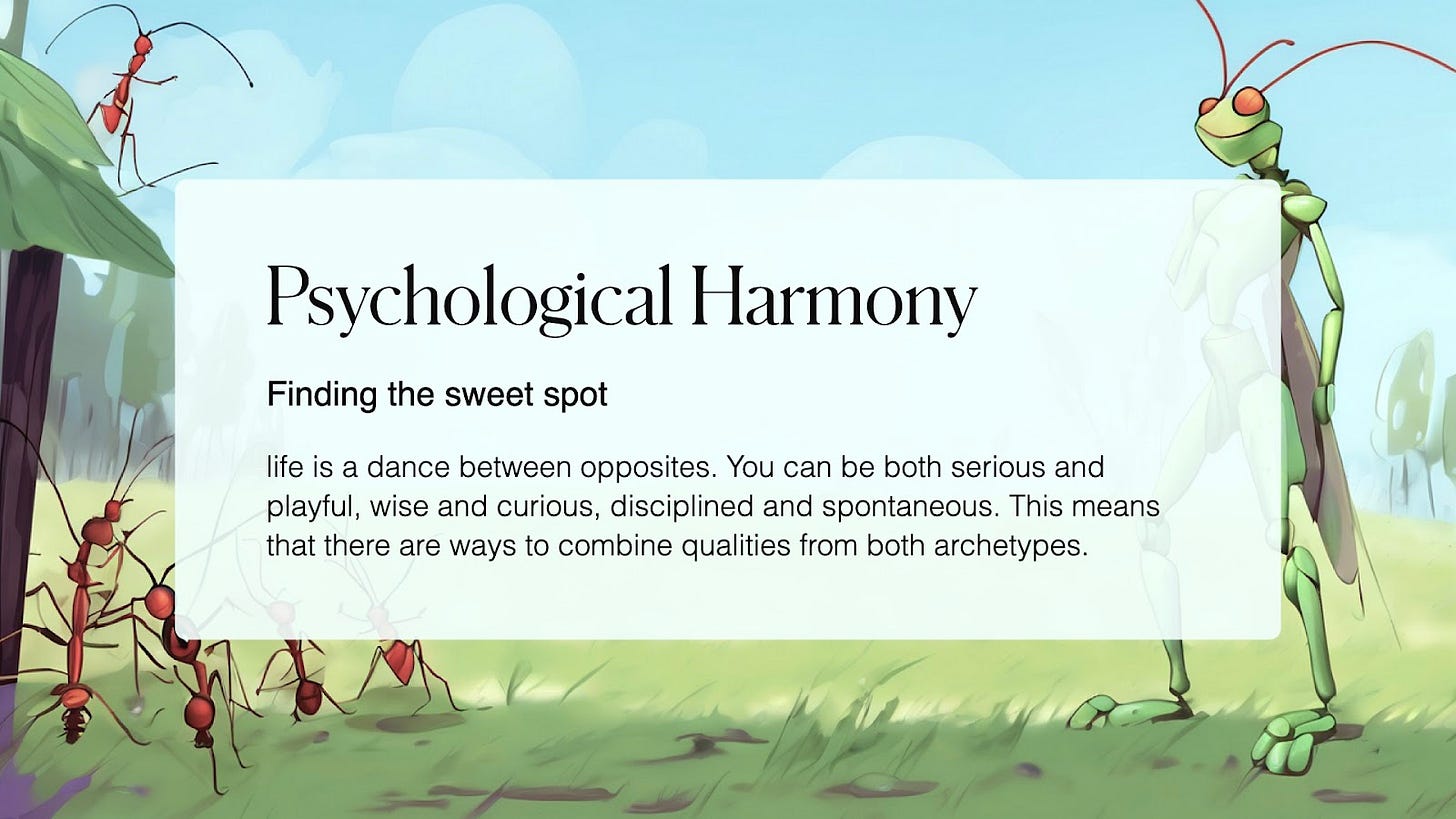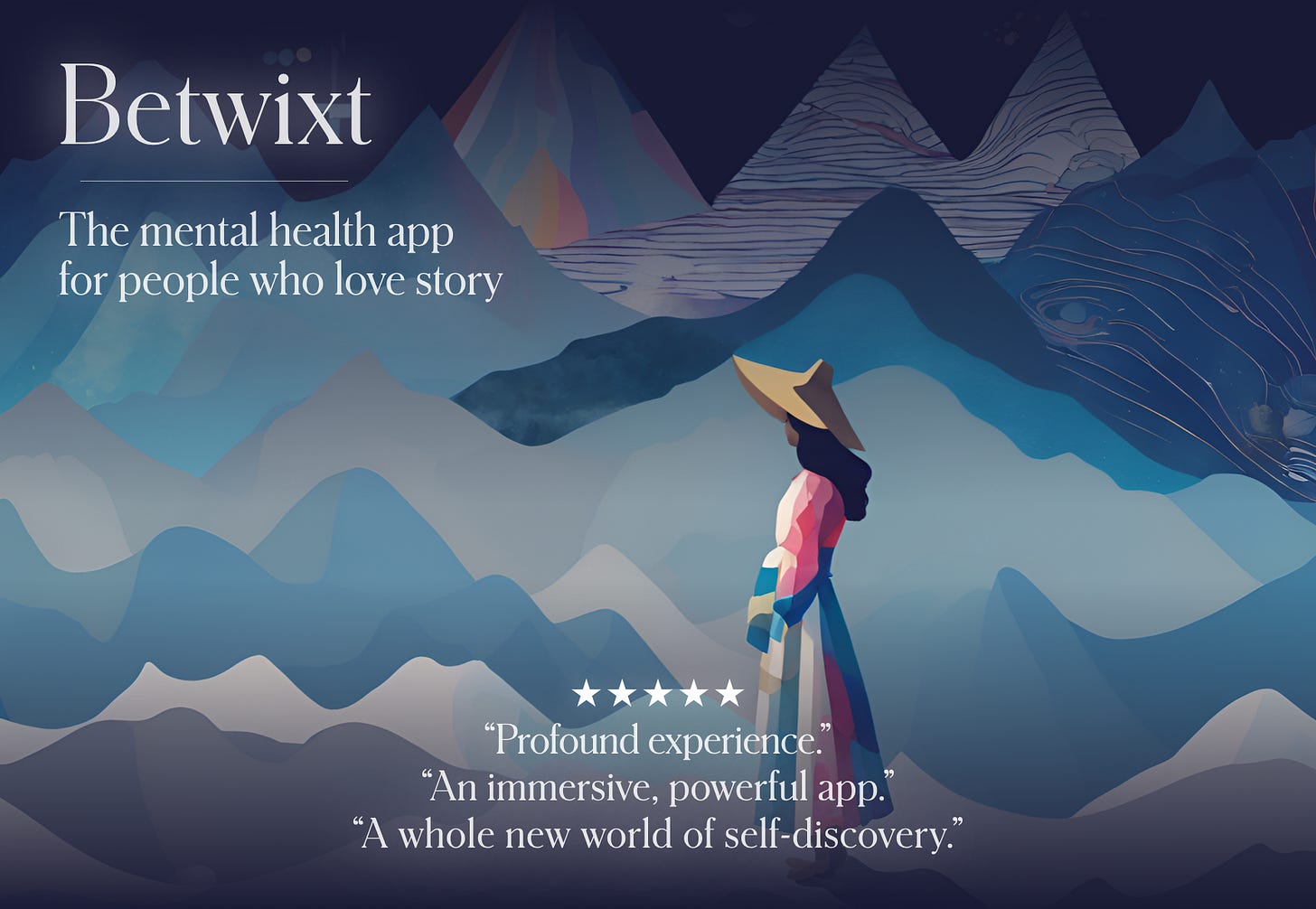The Myth of Futile Sloth:Why hustle culture hates rest (and why you need it)
The Story of the Grasshopper and the Ant – an ode to joy and the unmet need for play
You can listen to this piece on YouTube.
***
We live in a culture that celebrates industriousness and shames sloth. But what if taking time out was actually necessary for productivity, creativity and much more?
The story of The Ant & The Grasshopper has been used to shame laziness for centuries, but this is really a tale about balance. Let’s break it down.
Aesop's The Ant and the Grasshopper
One summer, when the sun shone bright and the world buzzed with warmth, a carefree grasshopper hopped about the meadow. He chirped his songs, leapt joyfully from blade to blade, and basked in the beauty of life. Near him, he noticed a group of ants, busy at work. They toiled tirelessly, carrying crumbs and seeds, far bigger than their own bodies, back to their nest.
“Why do you work so hard?” Grasshopper called out to one of them, pausing in his song. “The weather is perfect! Come, enjoy the sunshine and sing with me!”
The ant glanced at him but didn’t stop. “We’re preparing for winter,” it replied. “You should do the same. When the cold comes, there will be no food, and singing won’t fill your belly.”
“Winter is far away!” laughed Grasshopper. “I have plenty of time and this glorious sunshine is just too good to waste!"
But Ant and the rest of its troop marched on undeterred, their trails winding toward a well-stocked anthill. Grasshopper, ignoring their warning, simply snorted and continued his carefree life, singing and dancing through the summer.
But then, as it always does, winter arrived. The meadow turned white with frost, the leaves withered, and the once-abundant food disappeared. Grasshopper, cold and hungry, searched desperately for something to eat until he stumbled upon the ants’ home, warm and glowing with stored provisions.
He knocked at their door and begged, “Please, dear Ant, may I have some food? I'm starving and so very cold.”
Ant peered out at him. “We warned you,” it said. “There isn't enough here to share. You must learn to plan ahead, my friend.” And, with that, it retreated into its cosy little world, leaving Grasshopper to face the winter alone.
Sloth as the last (predictably) of the Seven Deadly Sins
As one of the seven dealies, sloth is probably the hardest to define – it refers to a range of different traits, according to who you're listening to.
The word sloth comes from the latin term acedia (meaning "without care") and was originally used to describe an affliction to monks who became indifferent to their religious duties and obligations to God. These days, sloth is most commonly used to describe laziness and inertia, and as such, it is hugely stigmatised in our success-hungry culture.
Seen through a more accepting (and in my opinion realistic) lens, sloth can be seen first as a response to the fundamental need for rest and recuperation. That's fairly obvious. But it can also be understood as downtime that must and will always come after acts of great determination – i.e. anything that stimulates an abundance of dopamine.
Have you ever looked forward to the end of one project so you can get going on that other project only to find that as soon as challenge no.1 was out of the way, you could do nothing but veg out for an entire week? That's what's going on there. Dopamine spikes are followed by crashes – the bigger the spike, the bigger the dip – and super low dopamine. We simply cannot feel motivated enough to get moving. It's not a choice; it's a neurological certainty.
But this isn't a bad thing.
While these crashes might feel horribly unproductive, important stuff is going on. First, we need downtime following a big achievement or failure if we're going to process and integrate these things: success doesn't just sink in the moment we achieve it; it takes a little time.
Second, without the lows, we can't get the highs, meaning that the dopamine rollercoaster keeps us more productive and motivated over time than if we tried to stay in an up state constantly.
Finally, and most interestingly, while high dopamine drives goal-directed focus, when levels drop, the brain gets to shift into a more diffuse, open-ended mode of thinking. This is when we experience insight-based creativity, where connections form between seemingly unrelated ideas, giving us those precious “aha!” moments that can bring all sorts of things together.
In short, no one can be on all the time and nobody wants to be either.
However, even though most of us can grasp this intellectually, we still judge ourselves for moments of lethargy, or turning down work or invites to social events due to a learned shame around sloth.
So, as with all the "sins" we've explored in this series, there's an interesting contradiction here. In Jungian terms, sloth is polarising; we struggle to see the middle ground, and therefore have a hard time accepting both our own lethargy and whatever (and whoever) else we see as lazy.
The reality, though, is that it's the polarisation that actually poses a threat.
Let's break down the fable of The Ant and the Grasshopper to see what can be done about it.
This tale embodies the archetypal tension between the Puer Aeternus (the eternal child, represented by Grasshopper), and the Senex (the wise elder, represented by Ant). Grasshopper’s carefree nature aligns with the child’s desire to remain in a state of eternal play and freedom, while Ant symbolises discipline, responsibility, and foresight.
Read literally, the story warns of the dangers of irresponsibility and sloth – we're supposed to side with Ant, it seems, and learn the virtues of hard work and orderly preparation.
From a Jungian perspective, though, the story can be read as a caution against an unbalanced psyche. No archetype is superior or "more correct" than any other; they are simply different forms of natural psychic energy.
And so, while Grasshopper’s failure lies in its inability to integrate the wisdom of the Senex, Ant may represent an overemphasis on duty and lack of joy. Neither has it right: Grasshopper suffers in winter, but Ant surfers in summer. Or, to put that another way, the carefree grasshopper neglects the future while the future-focused ants fail to experience the present.
“But it seems to me to be an imperfection in things of beauty, and a weakness in man, if an explanation from the shallow-side has a destructive effect. The horror which we feel for Freudian interpretations is entirely due to our own barbaric or childish naivete, which believes that there can be heights without corresponding depths, and which blinds us to the really "final" truth that, when carried to extremes, opposites meet.”
–Carl Jung
Jung taught that true individuation requires a union of opposites. In that case, this tale depicts a fractured, unintegrated psyche – one that hasn't yet found a solution for its inner conflict, which feels familiar, because we're still polarised in exactly this way as a society today.
The journey of change
So, how do we find balance?
A healthy psyche would incorporate the Senex’s wisdom, structure, and foresight without losing the Puer’s creativity, playfulness, and openness to new possibilities. That's the holy grail.
“It's easy to be a naive idealist. It's easy to be a cynical realist. It's quite another thing to have no illusions and still hold the inner flame.”
― Marie-Louise von Franz (possibly apocryphal)
“The healing hero, therefore, is the one who finds some creative way out, a way not already known, and does not follow a pattern.”
― Marie-Louise von Franz, The Problem of the Puer Aeternus
This leads us to another way to interpret this fable. Rather than two warring and irreconcilable opposites, what if this story depicts the journey to integration, along with the pain and discomfort required to achieve this?
Jungian psychologist Marie-louise von Franz devoted her life's work to the analysis of fairy tales and folklore. I haven't been able to find any writing of hers on this particular story but, based on her work in general, we might expect her analysis of this story to go something like this:
Grasshopper is a symbol of the immature psyche – one that avoids responsibility and remains fixed in the moment, refusing to engage with the future or reality. The ants, on the other hand, represent the collective wisdom of the unconscious, which is urging the Grasshopper toward transformation. When Grasshopper fails to listen, it suffers during the long, cold winter, but rather than seeing this as a punishment, perhaps this suffering is a necessary step towards maturity. We don't get to grow without growing pains, and psychological integration is inherently difficult because it requires the death of our old way of being and the traumatic birth of a new self.
Is sloth a sin?
So how can we apply any of this, and what does it mean about the sinfulness of sloth? Let's start with the cause of sloth in terms of neurology and psychology.
First of all, let's bust a damaging myth. You may have heard of the "couch potato gene" – a single gene supposedly associated with sloth, which took the world by storm when it first made the headlines. According to geneticist Adam Rutherord, the "couch potato gene" is a load of old nonsense. It's just not that simple. No single gene can be isolated and determined the cause of a behaviour like this.
So what causes our slothful moments? As mentioned, there's the simple fundamental need for rest: our bodies, including our brains, need rest in order to work properly.
Sometimes, though, we may appear lazy because we're anxious or overthinking – aks "analysis paralysis." In these instances, we find ourselves frozen in place by strong emotions, not a conscious decision to shirk responsibilities. Depression creates inertia too, of course, which is also out of our conscious control.
But this is where we get to the juicy stuff. What if I told you that where we position ourselves on the social hierarchy has a hand in this? What we perceive as our comparative level of status corresponds directly with dopamine receptors in the brain's reward network. So, the higher up we see ourselves on the societal ladder of success and worth, the more motivated we will be to get up and do stuff. If we perceive ourselves as worthless, as poor or inferior in other ways, then we'll find it much, much harder to rise up out of our state of inertia. It's not just a case of gritting our teeth – take dopamine away and we will be physically, neurologically incapable of motivating ourselves to try.
This is what poverty and shame do to the brain.
Rising up out of inertia
According to neuroscientist and clinical psychologist Professor Ian Robertson, there are ways to override our natural slothenly inclinations. One is to foster a sense of control in life. Robertson calls this a "psychological antidote to the corrosive effects of disempowerment".
Another is to foster a feeling of confidence: if you can train yourself to believe that you can do something, then the brain registers this as a future success and increases dopaminergic activity. Dopamine, by the way, is a natural antidepressant and anti-anxiety drug, as well as the driver of motivation and even frontal lobe activity, which essentially makes us that little bit smarter than we were while overcome by lethargy.
So, how do we create confidence and a sense of control in life? There's no magic wand, but one fairly universal rule is that we'll feel stronger and more connected to ourselves when we focus less on external forces or restrictions and more on what we can control: our choices, behaviours, responses. We need to focus on what we value, rather than what the world values or doesn't value about us.
We also need to look away, whenever we can, from the big picture of our futures – which can be so daunting and paralysing – and instead focus on the small steps we can take right now.
Obviously it's hard to take action when completely overcome by lethargy, but very few of us will be in that state all the time, and movement at any point can count.
The first step towards any goal, no matter how tiny, creates a new perspective: you meet and perceive new things; gain new resources; and, crucially, you can start to see yourself differently. Anyone else feel like a different person just because they made their bed in the morning? That's how small the steps can be to start building the sense of confidence and control that can fuel the activity cycle in a positive way.
Psychological Harmony: Finding the sweet spot
Remember that the Senex's counterpart – the Puer – is also vital for psychological harmony. If we adopt the wisdom of ants and live in that way, we may get a lot done, but we're also likely to march our way into burnout, isolation, depression, meaninglessness, physical illness and more.
We struggle to slow down in this world precisely because we have branded sloth as a sin, and as a result we not only risk our health but also our joy, peace, connection and play. We need to be Grasshopper sometimes, too.
So, how do we achieve this kind of balance? How do we integrate our inner Grasshopper and Ant?
First, we need to recognise that life is a dance between opposites. You can be both serious and playful, wise and curious, disciplined and spontaneous. This means that there are ways to combine qualities from both archetypes.
For example, you could plan a creative project (Senex) and execute it with joyful enthusiasm (Puer).
Similarly, you can schedule time (Senex) for spontaneity, play and daydreaming (Puer).
You can also cultivate the ability to set and respect your boundaries (Senex), while using them to protect time and space for creativity, improvisation and connection with others (Puer).
The battle between Grasshopper and Ant is not solved by an either/or, but a both/and. There are times in life to embrace the carefree energy of the Puer and times to embody the grounded wisdom of the Senex. Harmony comes from knowing when to shift between these roles.
***
References
Brandt J, Dahm B, McAllister D. A Perspectival Account of Acedia in the Writings of Kierkegaard. Religions. 2020; 11(2):80. https://doi.org/10.3390/rel11020080
Marie-Louise von Franz, author of “The Interpretation of Fairy Tales” and “Shadow and Evil in Fairy Tales”
Dr Adam Rutherford from the Department of Genetics, Evolution and Environment at University College London, speaking on BBC Sounds' Seven Deadly Psychologies
Professor Ian Robertson from the Department of Psychology at Trinity College Dublin, speaking on BBC Sounds' Seven Deadly Psychologies
Thank you for reading!
We’re Hazel (ex boxer, therapist and author) and Ellie (ex psychology science writer). We left our jobs to build an interactive narrative app for self-awareness and emotion regulation (Betwixt), which you can try on Android here and on iOS here.














I just finished the last dream in Betwixt and want to say thank you for helping me explore myself. I have had many epiphanies and changes in the way I talk to and deal with myself and my emotions because of my experience with Betwixt.
In the version of this story that I grew up with, the grasshopper was nearly dead from the cold when he reached the ants, but they did let him in. They said he had to earn his keep by playing music for them while they danced and feasted throughout the winter. So they were integrated in the end.